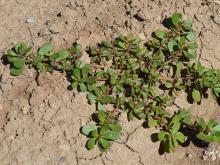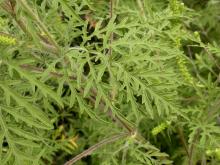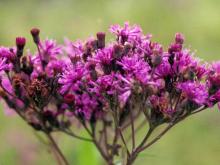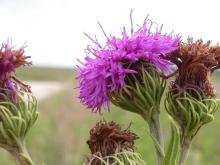Wildflowers, Grasses and Other Nonwoody Plants
Media

Species Types
Scientific Name
Symphyotrichum spp. (formerly Aster spp.)
Description
Missouri has 24 species of New World asters in genus Symphyotrichum. Most have purple or white ray flowers and yellow disk flowers that turn reddish over time. Most bloom in late summer and fall.
Media

Species Types
Scientific Name
Cuscuta spp.
Description
Dodders are easy to identify, even though at first you might not recognize them as plants. These parasitic plants usually look like a hairlike mass of yellow or orange, leafless, wiry, vining stems wrapping around the stems of other plants.
Media

Species Types
Scientific Name
Portulaca oleracea
Description
Purslane can be an aggressive pest in gardens and is one of the worst agricultural weeds in the world. Meanwhile, it’s also a favorite wild vegetable served cooked or raw, and many people cultivate it.
Media

Species Types
Scientific Name
Viola viarum
Description
The leaf blades of plains, or wayside violet are highly variable, and the plant produces differently shaped leaves as the season progresses. It’s quite similar to cleft violet, but the leaves are smooth and hairless.
Media

Species Types
Scientific Name
Rumex crispus
Description
Curly dock’s rosettes of wavy-edged, leathery leaves are a common sight on roadsides and other disturbed lands. The fruit clusters at the top half of the plant turn dark rusty brown and are easy to spot from a distance.
Media

Species Types
Scientific Name
Scrophularia marilandica
Description
Eastern figwort occurs statewide in rich woods, woodland borders, and bottomlands. It’s usually 2-5 feet high, has square stems and lance-shaped, toothed leaves, and bears spreading clusters of small, green scoop-shaped flowers with brown petal lobes.
Media

Species Types
Scientific Name
Vernonia missurica
Description
Missouri ironweed is one of Missouri’s five species of ironweeds. Most common in the eastern half of the state, it is a hairy ironweed with a relatively large number of florets per flowerhead.
Media

Species Types
Scientific Name
Ambrosia artemisiifolia
Description
Common ragweed is instantly recognizable by its ornate, 2–3 times pinnately lobed, hairy leaves. You’ve probably seen it many times and wondered what it was.
Media

Species Types
Scientific Name
Vernonia spp.
Description
Five species of ironweeds live in Missouri. Starting in the middle of summer, they bear showy clusters of magenta or purple flowerheads at the branching tops of upright stalks.
Media

Species Types
Scientific Name
Vernonia arkansana
Description
Curlytop ironweed is one of Missouri’s five species of ironweeds. It’s easy to identify because of its tapering, curling, threadlike involucral bracts. Also, it is usually a smooth, hairless plant.
See Also
About Wildflowers, Grasses and Other Nonwoody Plants in Missouri
A very simple way of thinking about the green world is to divide the vascular plants into two groups: woody and nonwoody (or herbaceous). But this is an artificial division; many plant families include some species that are woody and some that are not. The diversity of nonwoody vascular plants is staggering! Think of all the ferns, grasses, sedges, lilies, peas, sunflowers, nightshades, milkweeds, mustards, mints, and mallows — weeds and wildflowers — and many more!





















